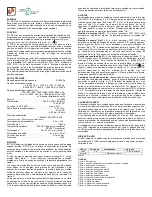
26
Fig 13 Typical alarm application
10.4.3 Alarm configuration
Alarm configuration may be performed via the
HART
digital communication, see the BA47X/67X
Indicating Temperature Transmitter HART
Interface
Guide which may be downloaded from
www.beka.co.uk/manuals, or using the configuration
menu which is accessed via the four push buttons
located behind the instrument switch cover, see Fig
7. When frequent adjustments are required the
transmitter can be supplied with a keypad mounted
on the outside of this cover.
When a BA474D indicating temperature transmitter is
supplied with optional alarms the conditioning menu
is extended as shown in Fig 14. The additional
alarm functions appear between 'bAr' and 'CodE' in
the configuration menu. For simplicity Fig 14 only
shows the additional sub-functions for alarm 1, but
alarm 2 has identical sub-functions.
The following table summarises each of the alarm
configuration functions and includes a cross
reference to more detailed information. Again only
the functions for alarm 1 are listed, but alarm 2 has
identical functions.
Summary of programmable alarm functions
Display
Description of function
‘ALr1’ Alarm
1
‘ALr2’
Alarm 2
The two functions
e
ach contain seven
identical sub-functions, one set for
configuration alarm 1 and the other for
configuration alarm 2.
See section 10.4.4 and Fig 14.
'EnbL'
Alarm enable
Enables or disables the alarm function
without changing the alarm parameters.
See section 10.4.5
'SP1'
Alarm setpoint 1
Adjusts the alarm setpoint. The alarm is
activated when the indicator display
equals the setpoint.
See section 10.4.6
'Hi.Lo'
Alarm function
Defines whether the alarm has a high or
low function.
See section 10.4.7
'no.nC'
Normally open or normally closed
output
Determines whether the single pole alarm
output is open or closed in the non-alarm
condition.
See section 10.4.8
'HStr'
Hysteresis
Adjusts the alarm hysteresis.
See section 10.4.9
'dELA'
Alarm delay
time
Adjusts the delay between the display
equalling the setpoint and the alarm
output being activated.
See section 10.4.10
'SiL'
Alarm silence time
Defines the time that the alarm output
remains in the non-alarm condition
following acceptance of an alarm.
See section 10.4.11
'ACSP'
Access setpoint
Enables direct access to the alarm
setpoints from the transmitter operational
mode i.e. when it is displaying
temperature. Access may be protected
by a separate security code.
See section 10.4.12
















































